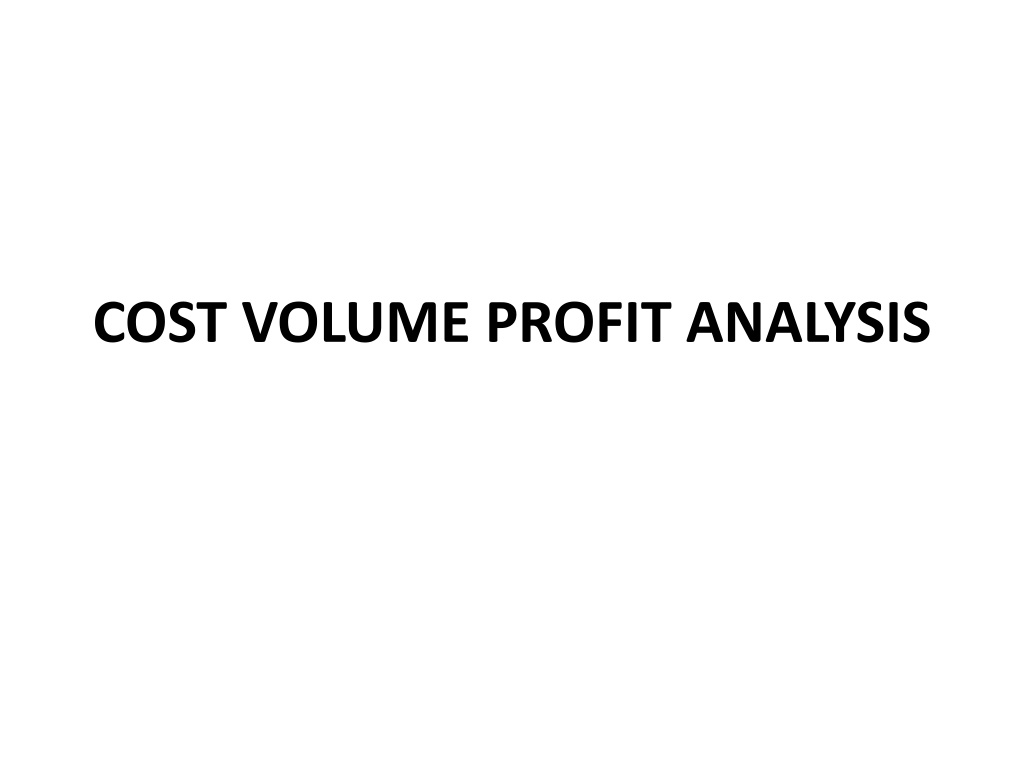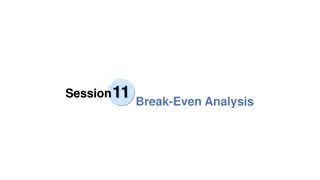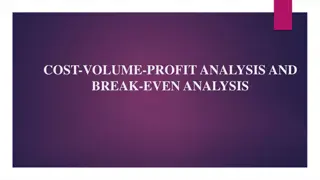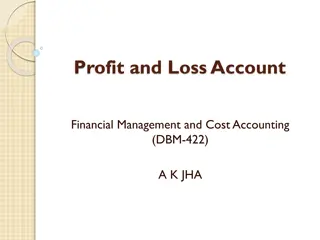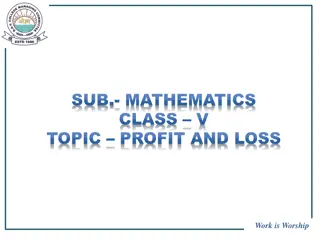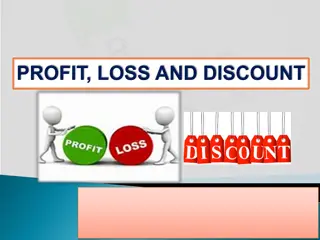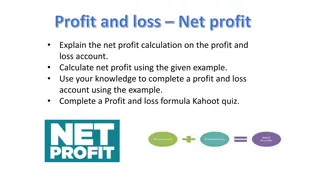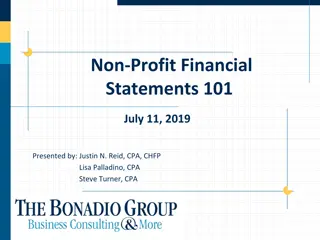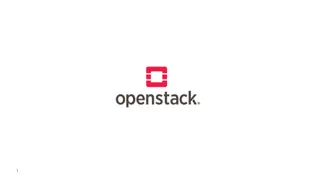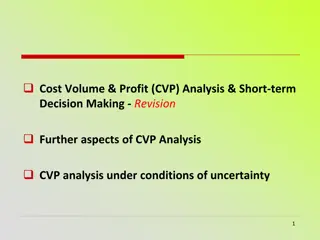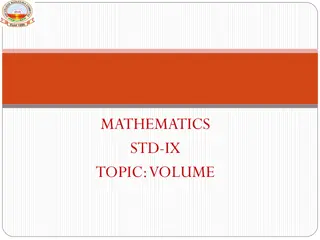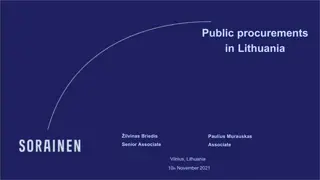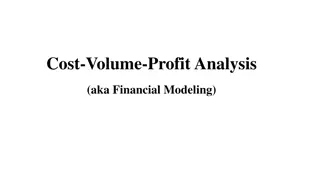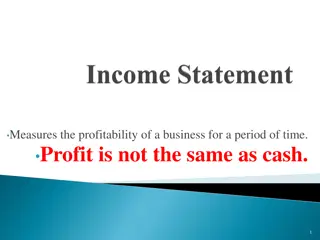Understanding Cost Volume Profit (CVP) Analysis
Explore the concepts of CVP analysis including contribution margin, break-even analysis, margin of safety, and profitability changes. Learn how key factors affect profitability and how to compute required sales for desired profit levels. Discover the impact of different variables on costs and revenues through practical questions and examples.
Download Presentation

Please find below an Image/Link to download the presentation.
The content on the website is provided AS IS for your information and personal use only. It may not be sold, licensed, or shared on other websites without obtaining consent from the author. Download presentation by click this link. If you encounter any issues during the download, it is possible that the publisher has removed the file from their server.
E N D
Presentation Transcript
In this session we shall cover What is CVP Analysis? Concept of Contribution margin Break even analysis What is Margin of safety? How changes profitability? Concept of Cash BE point and Composite BE point Computation of required sales for desired level of profit How is Key factor incorporated in CVP analysis? in different variables affect
CVP Analysis Some questions What effect on profit can an additional flight from Chicago to New York, for an airline company? How will the profit change if the ratings of an evening news program increase, for a news channel? How many days of care for patients is required for the hospital to break even?
CVP Analysis Some questions What effect on profit can an additional flight from Chicago to New York, for an airline company? How will the profit change if the ratings of an evening news program increase, for a news channel? How many days of care for patients is required for the hospital to break even? Each of these questions concerns the effects on costs and revenues when the organisation s activity changes!
CVP Analysis Profit is a result of many factors: Selling price Volume Variable cost / unit Fixed cost Sales mix
Techniques of CVP Analysis Contribution Margin concept Break even Analysis Profit Volume Analysis
Contribution margin concept Different costs categorized as either fixed or variable Contribution: excess of sales over variable cost It is that part of revenue which is available to contribute towards recovering fixed costs and profit Unit contribution margin = S.P/ unit VC/ unit Contribution margin ratio = unit contribution margin unit sales price Also known as C/S ratio or P/V ratio
Example Contribution margin Sales = Rs 10 lakhs Variable cost = Rs 6 lakhs Fixed cost = Rs 3 lakhs Contribution = 10 6 lakhs = Rs 4 lakhs P/V Ratio = 4/10 x 100 = 40% The above means that on every Re 1 of sale, 40% i.e. 40 paisa would be available in form of contribution, which would then be used for recovering fixed costs and contributing towards profit. What this also implies is that once fixed costs are recovered in full, any additional sales, after meeting VCs, would be directly available as profit
Break even analysis BE point: that volume of activity where the organization's revenues and expenses are equal At this level of sales, there is no profit / no loss i.e. it breaks even BE sales (units) = Fixed cost / unit contribution BE sales (value) = Fixed cost / Contribution to sales ratio
Example BE Analysis S.P / unit = Rs 20 VC / unit = Rs 4 FC = Rs 80,000 Unit contribution = 20 4 = Rs 16 PV ratio = 16/20 x 100 = 80% BE (units) = 80,000 /16 = 5,000 units BE (value) = 80,000 / 80% = Rs 1,00,000 The above analysis means that the company would break even by selling 5000 units. On every additional unit sold after 5000 level, after providing for VCs, 80% of sale amount would directly be converted into profit.
Margin of safety Difference between actual sales and BE sales Indicates towards the buffer that would be available in case of a drop in sales, to keep the company at a level above BE. If this difference is small, it indicates towards a risky proposition
Example Margin of safety Current level of sales = Rs 10 lakhs FC = Rs 3 lakhs Profit = Rs 2 lakhs Contribution = FC + Profit = Rs 5 lakhs PV Ratio = (5 lakhs / 10 lakhs) x 100 = 50% BE sales = FC / PV ratio = 3 lakhs / 50% = Rs 6 lakhs MOS = 10 lakhs 6 lakhs = Rs 4 lakhs Suppose the SP/unit = Rs 100, then a drop in sales by upto 4000 units (i.e. 4,00,000 / 100) would still keep the company in positive profit position.
Example BE and MOS with subsequent changes Mint Electro, a manufacturer of AM/FM radios has prepared the following cost sheet for the current financial year: Fixed costs: (in Rs 00s) Staff salaries 1, 20,000 Office costs 80,000 Advertisement costs 40,000 Variable costs / unit Rs 2500 Selling price Rs 4000 The company currently sells 24000 units in a year. It was a pioneer in the production of AM/FM radios when it entered the space in 2001. Over the period of time, the electronics goods sector has witnessed intense competition. In light of the changed scenario, the company is contemplating a shift in its strategies to give a boost to its top line. Calculate the current break even point and MOS. Assuming a drop in sales is expected to 20,000 units in case no new strategies are initiated to keep the margins intact, how would it affect profit? If an additional staff salary of Rs 33, 00,000 is anticipated and the selling price is increased by 15%, at what level of sales would the company then break even?
Calculation of Current break even and MOS SP - VC Contribution 1500 4000 (2500) Total FC = 240 L Thus, BE = 240 L / 1500 = 16000 units MOS = Current sales BE sales = 24,000 16000 = 8000 units
When drop in sales is expected to 20,000 units Contribution / unit = Rs 1500 Sales = 20,000 units Thus, total contribution = 1500*20000 = Rs 300L Profit = 300L 240L = Rs 60L
Calculation of new BE with an additional staff salary and selling price increase Additional staff salary is a FC Thus, new FC = 240L + 33L = 273L New selling price = 4000 + 15% of 4000 = 4600 New contribution = 4600 2500 = 2100 Thus, new BE = 273L / 2100 = 13000 units
Cash BE point Point where cash inflows on account of sales are just sufficient to meet cash fixed costs. Used to analyze the liquidity position Cash BE (units) = Cash FC / unit contribution Cash BE (value) = Cash FC / PV Ratio Cash BE would be at a level lower than Normal BE
Composite BE point This is of consideration in case of multiple product lines
Example Composite Break even ABS Ltd. is a manufacturer of florescent lamps. There are three types of lamps Flore Light, Flore Medium and Flore High manufactured and sold by the company. The sales mix in value comprises 35%, 42% and 23% of the three types of lamps respectively. The total budgeted sales for the company are Rs 50, 00,000 per month. The operating costs as a percentage of sales are 55%, 62% and 76.5% respectively for the three lamps. The company incurs an average fixed cost of Rs 18, 25,000 per month. What will be the overall break even point for the company? Also indicate the product wise contribution margin.
Example Composite Break even Products Sales mix FL 0.35 FM 0.42 FH 0.23
Example Composite Break even Products Sales mix Sales FL 0.35 17.5 L FM 0.42 21 L FH 0.23 11.5 L 50 L
Example Composite Break even Products Sales mix Sales VC FL 0.35 17.5 L 9.625 L FM 0.42 21 L 13.02 L FH 0.23 11.5 L 8.7975 L 50 L
Example Composite Break even Products Sales mix Sales VC Contribution FL 0.35 17.5 L 9.625 L 7.875 L FM 0.42 21 L 13.02 L 7.98 L FH 0.23 11.5 L 8.7975 L 2.7025 L 50 L 18.5575 L
Example Composite Break even Products Sales mix Sales VC Contribution FL 0.35 17.5 L 9.625 L 7.875 L FM 0.42 21 L 13.02 L 7.98 L FH 0.23 11.5 L 8.7975 L 2.7025 L 50 L 18.5575 L P/V ratio = 18.5575 * 100 = 37.115 % 50 L Given that the FC = Rs 18.25 L, BE (value) = 18.25 L / 37.115% = Rs 49.17 Lakhs
Desired profit Determination of sales level that would be required to achieve the desired profit objective The desired profit may be expressed in various forms: As an absolute amount On a per unit basis As a % of sales
Computation of required sales for desired profit Desired profit as an absolute amount: Required sales = FC + Desired profit unit contribution Desired profit on a per unit basis: Required sales = FC / (unit contribution profit / unit) Desired profit as % of sales: Required sales = FC / (PV ratio profit %)
Key factor/ Scarce resource analysis At times, a factor of production may be limited In such cases, with multiple products using the same limited resource, the product having the highest contribution margin/ unit of the key factor should be given top priority
Example Key factor analysis Delicacies Ltd. is into production of three types of chocolate cookies Chocolava, Chocochip and Chocobliss. The following financial information is given: Chocolava Selling price/ unit 100 PV Ratio 10% Maximum sales potential (units) 40,000 Raw material as % of VC 50% Chocochip 75 20% Chocobliss 50 40% 25,000 10,000 50% 50% Total Fixed costs = Rs 6,80,000. The company uses single raw material for all the three products. The management is faced with the problem of raw material being in short supply. The company has a quota of material of value Rs 18,00,000. Compute: The product mix that will give maximum overall profit keeping in view the shortage of raw material. Also compute the maximum possible profit.
Example Key factor analysis Chocolova Chocochip chocobliss Selling price 100 75 50
Example Key factor analysis Chocolova Chocochip chocobliss Selling price 100 75 50 P/V 10% 20% 40%
Example Key factor analysis Chocolova Chocochip chocobliss Selling price 100 75 50 P/V 10% 20% 40% Contribution 10 15 20
Example Key factor analysis Chocolova Chocochip chocobliss Selling price 100 75 50 P/V 10% 20% 40% Contribution 10 15 20 VC 90 60 30
Example Key factor analysis Chocolova Chocochip chocobliss Selling price 100 75 50 P/V 10% 20% 40% Contribution 10 15 20 VC 90 60 30 Raw material cost 45 30 15
Example Key factor analysis Chocolova Chocochip chocobliss Selling price 100 75 50 P/V 10% 20% 40% Contribution 10 15 20 VC 90 60 30 Raw material cost 45 30 15 Contribution as a percentage of raw material cost (10/45) * 100 = 22.22% 50% 133.33%
Example Key factor analysis Chocolova Chocochip chocobliss Selling price 100 75 50 P/V 10% 20% 40% Contribution 10 15 20 VC 90 60 30 Raw material cost 45 30 15 Contribution as a percentage of raw material cost (10/45) * 100 = 22.22% 50% 133.33% Ranking 3 2 1
Example Key factor analysis Chocolova Chocochip Chocobliss Units 40,000 25,000 10,000 Raw material cost 45 30 15 Ranking 3 2 1
Example Key factor analysis Chocolova Chocochip Chocobliss Units 40,000 25,000 10,000 Raw material cost 45 30 15 Ranking 3 2 1 Total value of raw material available 18,00,000
Example Key factor analysis Chocolova Chocochip Chocobliss Units 40,000 25,000 10,000 Raw material cost 45 30 15 Ranking 3 2 1 Total value of raw material available 18,00,000 - Consumed by Chocobliss (10,000 * 15) (1,50,000) 16,50,000
Example Key factor analysis Chocolova Chocochip Chocobliss Units 40,000 25,000 10,000 Raw material cost 45 30 15 Ranking 3 2 1 Total value of raw material available 18,00,000 - Consumed by Chocobliss (10,000 * 15) (1,50,000) 16,50,000 - Consumed by chocochip (25,000 * 30) (7,50,000)
Example Key factor analysis Chocolova Chocochip Chocobliss Units 40,000 25,000 10,000 Raw material cost 45 30 15 Ranking 3 2 1 Total value of raw material available 18,00,000 - Consumed by Chocobliss (10,000 * 15) (1,50,000) 16,50,000 - Consumed by chocochip (25,000 * 30) (7,50,000) AVAILABLE FOR Chocolova 9,00,000
Example Key factor analysis Chocolova Chocochip Chocobliss Units 40,000 25,000 10,000 Raw material cost 45 30 15 Ranking 3 2 1 Total value of raw material available 18,00,000 - Consumed by Chocobliss (10,000 * 15) (1,50,000) 16,50,000 - Consumed by chocochip (25,000 * 30) (7,50,000) AVAILABLE FOR Chocolova 9,00,000 Cost / unit 45
Example Key factor analysis Chocolova Chocochip Chocobliss Units 40,000 25,000 10,000 Raw material cost 45 30 15 Ranking 3 2 1 Total value of raw material available 18,00,000 - Consumed by Chocobliss (10,000 * 15) (1,50,000) 16,50,000 - Consumed by chocochip (25,000 * 30) (7,50,000) AVAILABLE FOR Chocolova 9,00,000 Cost / unit 45 Thus, units of Chocolova 9,00,000 / 45 = 20,000 units
Example Key factor analysis Product mix would be: Chocolova : 20,000 units Chocochip : 25,000 units Chocobliss : 10,000 units Chocolova Chocochip Chocobliss Units 20,000 25,000 10,000 Contribution / unit 10 15 20 Contribution 2,00,000 3,75,000 2,00,000 Thus, Total contribution = 7,75,000 - Fixed cost (6,80,000) Profit 95,000
To summarise An understanding of CVP relationships is necessary for the successful management of any enterprise CVP analysis summarizes the effects of changes in the organisation s volume of activity on its costs, revenues and profit Contribution is that part of revenue which is available to contribute towards recovering fixed costs and profit BE point is that volume of activity where the organization's revenues and expenses are equal The other related concepts are MOS, Cash BE, Composite BE etc. At times when a factor of production is limited, the product having the highest contribution margin/ unit of the key factorshould be given top priority
